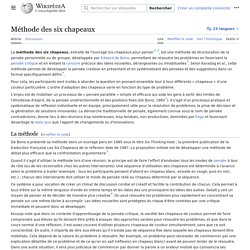

"6 thinking hats" Six Thinking Hats. 6-thinking-hats.jpg 800x565. 6 Thinking Hats - Bono de, Edward. The Six Thinking Hats technique (6TH) of Edward de Bono is a model that can be used for exploring different perspectives towards a complex situation or challenge.

Seeing things in various ways is often a good idea in strategy formation or complex decision-making processes. The 6TH technique is designed to help individuals deliberately adopt a variety of perspectives on a subject that may be very different from the one that they might most naturally assume. In wearing a particular thinking hat, people play roles, or "as if" themselves into a particular perspective.
For instance, one could play the devil’s advocate, even if only for the sake of generating discussion. The purpose of devil’s advocacy is to deliberately challenge an idea: be critical, look for what is wrong with it. Each of the Hats is named for a color that is mnemonically descriptive of the perspective one adopts when wearing the particular hat. The 6 hats and the perspectives they represent are: Six Thinking Hats. Six Thinking Hats is a book by Edward de Bono which describes a tool for group discussion and individual thinking involving six colored hats.

"Six Thinking Hats" and the associated idea parallel thinking provide a means for groups to plan thinking processes in a detailed and cohesive way, and in doing so to think together more effectively.[2] Underlying principles[edit] The premise of the method is that the human brain thinks in a number of distinct ways which can be deliberately challenged, and hence planned for use in a structured way allowing one to develop tactics for thinking about particular issues. de Bono identifies six distinct directions in which the brain can be challenged. In each of these directions the brain will identify and bring into conscious thought certain aspects of issues being considered (e.g. gut instinct, pessimistic judgement, neutral facts).
Since the hats do not represent natural modes of thinking, each hat must be used for a limited time only. 6-Thinking-Hats-POSTER.jpg (Image JPEG, 1152x864 pixels) - Redimensionnée (92%) Dialogue1.png (Image PNG, 2578x1675 pixels) - Redimensionnée (48%) The de Bono Group - Six Thinking Hats. Used with well-defined and explicit Return On Investment success in corporations worldwide, Six Thinking Hats is a simple, effective parallel thinking process that helps people be more productive, focused, and mindfully involved.

A powerful tool set, which once learned can be applied immediately! You and your team members can learn how to separate thinking into six clear functions and roles. Each thinking role is identified with a colored symbolic "thinking hat. " By mentally wearing and switching "hats," you can easily focus or redirect thoughts, the conversation, or the meeting. Using Six Thinking Hats®, you and your team will learn how to use a disciplined process which will... Six Thinking Hats by Edward de Bono. Méthode des six chapeaux.
Un article de Wikipédia, l'encyclopédie libre.

Pour cela, chaque participant prend un « chapeau » d'une couleur particulière, lui assignant ou lui reconnaissant un rôle. Ce chapeau peut changer durant la réunion. Il peut aussi être identique à celui d'autres participants. La méthode[modifier | modifier le code] Quand il s'agit d'utiliser la méthode lors d'une réunion, le principe est de faire l’effort d’endosser tous les modes de pensée à tour de rôle (ou de les reconnaître chez les autres intervenants).
Ce système a pour vocation de créer un climat de discussion cordial et créatif et facilite la contribution de chacun. On peut résoudre les problèmes plus rapidement en concentrant sa pensée sur la tâche à accomplir. Quand il s'agit d'un management personnel, l'effort se porte sur le changement successif des modes de pensée.
Les différents chapeaux[modifier | modifier le code] Edward de Bono. Edward de Bono (born 19 May 1933) is a Maltese physician, author, inventor and consultant.

He originated the term lateral thinking,[citation needed] wrote the book Six Thinking Hats and is a proponent of the deliberate teaching of thinking as a subject in schools. Biography[edit] Professor de Bono has held faculty appointments at the universities of Oxford, Cambridge, London and Harvard.[1] He is a professor at Malta, Pretoria, Central England and Dublin City University. De Bono holds the Da Vinci Professor of Thinking chair at University of Advancing Technology in Tempe, Arizona, USA.[2] He was one of the 27 Ambassadors for the European Year of Creativity and Innovation 2009.[3] He has written 57 books with translations into 34 languages.[1] He has taught his thinking methods to government agencies, corporate clients, organizations and individuals, privately or publicly in group sessions.
Ideas[edit] Critiques[edit] In the Handbook of Creativity, Robert J. De Bono for Business.